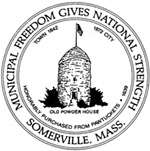 Following a unanimous vote by the Board of Aldermen May 8, Mayor Joe Curtatone announces that the city became the first municipality in the state to pass a Complete Streets Ordinance, and the sixth community in Massachusetts to enact related policies.
Following a unanimous vote by the Board of Aldermen May 8, Mayor Joe Curtatone announces that the city became the first municipality in the state to pass a Complete Streets Ordinance, and the sixth community in Massachusetts to enact related policies.
Based on national and international best practices, Somerville’s ordinance codifies the city’s ongoing mission of creating and supporting safe, convenient and healthier modes of transportation for all users by ensuring that Somerville’s streets are designed to encourage walking, biking and public transportation use while reducing automobile dependency and congestion. It will also enable convenient active transportation as part of daily activities, improve residents’ health by addressing a wide array of health and environmental issues, encourage walkable economic/business development, and meet the needs of all users of streets, including children, older adults and persons with disabilities.
“A major goal set forth by our community members in SomerVision [the city’s 20-year comprehensive plan] prescribes the development of a street network that is conducive to safe and enjoyable use as part of a multi-modal transportation network that promotes sustainability, and our Complete Streets Ordinance addresses this head on,” Curtatone said.
“Having served as the acting chair of the committee discussing this important piece of legislation, I am excited to move forward with the implementation of Somerville’s Complete Streets program to continue to help our community realize the goals outlined in SomerVision and integrate this type of planning into all projects we undertake in the city,” Alderman at Large Mary Jo Rossetti said. “Its successes and importance not only here in Somerville but nationwide are well documented, and it will be a great asset to an already forward-thinking community.”
Somerville Bicycle Committee Chairman Alex Epstein agreed.
“I applaud the city of Somerville for continuing to assure that its streets are designed, built and retrofitted for the benefit of all people—those walking, bicycling, using buses, and driving,” he said. “With bicycle traffic increasing by over 50 percent in the past two years while car traffic on some streets has actually declined, this is an ideal time to formalize the city’s use of National Association of City Officials street design standards that better prioritize the safety of people who walk, bike and use the T.”
What is ‘Complete Streets’?
Complete Streets is the planning, scoping, design, implementation, operation and maintenance of roads in order to reasonably address the safety and accessibility needs of users of all ages and abilities, considering the needs of motorists, pedestrians, transit users and bicyclists. The infrastructure integrated within Complete Streets plans provide safe travel experiences for all users while supporting and encouraging non-motorized transportation and prioritizing the needs of the most vulnerable users: children, the elderly and persons with disabilities. Such physical street design features include but are not limited to:
- Pedestrian focused elements: sidewalks; accessible curb ramps; high-visibility, raised crosswalks and tables; pedestrian signals, including leading, countdown, and or accessible signals for the blind; improvements that provide ADA (Americans with Disabilities Act) compliant accessibility; improved pedestrian access to transit stops and bus shelters; and signage.
- Bicycle-focused elements: conventional and buffered bicycle lanes; cycle tracks; or shared-use lanes when lanes are not feasible; paved shoulders; bicycle parking facilities.
- Traffic calming and/or greening elements: street trees and landscaping; marked automobile lanes; curbs; modern roundabouts, traffic bumps, raised tables and crosswalks; raised medians; surface treatments such as paving blocks, textured asphalt, and concrete.
- Transit focused elements: safe and attractive public transportation stops and facilities; transit priority signalization; bus stop curb extensions to prevent obstruction by parked cars; queue jump lanes for buses, and where applicable dedicated transit lanes.
“Complete Streets programs not only provide tremendous health, quality of life and other benefits to our infrastructure, they also support economic growth and community stability by providing accessible and efficient connections, as well as reducing greenhouse gas emissions and providing countless other positive impacts, particularly for densely settled urban communities,” Board of Aldermen President Bill White said. “I am pleased that the mayor and Board of Aldermen were able to work together to craft and pass this innovative ordinance.”
For more information about the city’s Complete Streets program, visit http://www.somervillema.gov/departments/ospcd/by-design, or www.somervillebydesign.com.















Reader Comments